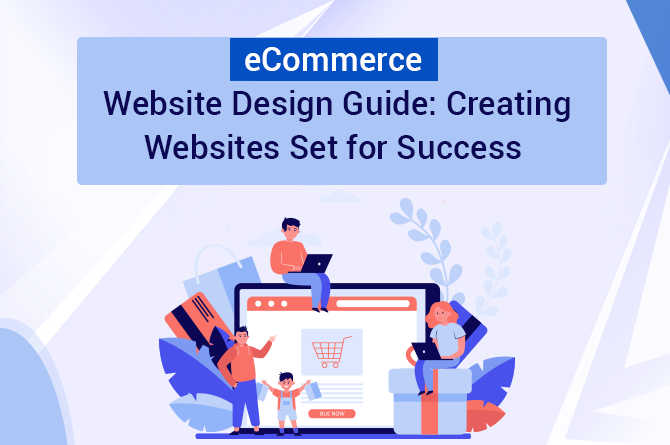In today’s digital age, having a well-designed and user-friendly eCommerce website is crucial for any business looking to succeed in the online marketplace. With the right eCommerce website services, you can create a platform that attracts customers and enhances their shopping experience, leading to increased conversions and customer satisfaction.
In this comprehensive guide, we will explore the key elements and best practices for designing an eCommerce website that is set for success.
Table of Contents
ToggleWhat Is an eCommerce Website?
An eCommerce website is an online platform where businesses showcase and sell their products or services to customers. It is a virtual storefront that allows transactions to occur electronically. With the help of eCommerce services, businesses can set up their online stores and reach a global audience.
These websites provide a range of features and functionalities designed to facilitate the buying and selling process. Customers can browse product catalogs, add items to their carts, make secure payments, and track orders. On the other hand, businesses can manage inventory, process orders, handle customer inquiries, and analyze sales data through the website’s backend.
For Example: Imagine a company that specializes in handmade jewelry. Using eCommerce services, they can create a website that showcases their unique designs, provides detailed product descriptions, and enables customers to purchase easily. This opens up opportunities for the business to expand its reach, increase sales, and establish a strong online presence.
What Are the Essential Elements of a Good Web Design?
A good web design encompasses several essential elements that work together to create a visually appealing, user-friendly, and effective website. Here are some key elements:
- Purposeful Layout
A well-designed website has a clear, organized layout that guides users through content. It should be easy to navigate, with intuitive menus and a logical information hierarchy.
- Visual Appeal
Aesthetics play a vital role in web design. Effective use of color schemes, typography, graphics, and whitespace can enhance the overall visual appeal and make the website engaging and visually pleasing.
- Responsive Design
With the increasing use of mobile devices, a responsive design is crucial. The website should adapt to different screen sizes and resolutions, ensuring an optimal user experience on smartphones, tablets, and desktops.
- Clear and Readable Typography
Choose fonts that are legible and appropriate for the content. Maintain consistency in font styles, sizes, and spacing throughout the website for a cohesive look. Pay attention to line lengths to avoid long, unreadable lines of text.
- Effective Use of White Space
White space (negative space) refers to the empty areas between elements. Properly utilizing white space can improve readability, create visual balance, and draw attention to essential elements.
- Consistent Branding
Maintain consistency in branding elements such as logos, color schemes, and typography. This reinforces brand identity and helps users associate the website with your brand.
- Fast Loading Times
Optimize the website’s performance to ensure quick loading times. Users expect fast and responsive websites and slow loading times can lead to frustration and increased bounce rates.
- User-friendly Navigation
Intuitive navigation is essential for users to quickly find what they’re looking for. Use clear and descriptive menu labels, include search functionality, and implement breadcrumb navigation to help users understand their location within the website.
- Accessibility
Design your website to be accessible to all users, including those with disabilities. Follow accessibility guidelines to ensure that people with visual impairments or other disabilities can access and use your website effectively.
- Call-to-Action (CTA) Elements
Use clear and prominent CTA buttons or links to guide users to take desired actions. Whether it’s making a purchase, signing up for a newsletter, or contacting you, CTAs should be easily visible and compelling.
- High-Quality Content
Great design should be complemented by high-quality, well-structured content. Ensure your content is informative, engaging, and relevant to your target audience. Use headings, subheadings, bullet points, and other formatting techniques to make it scannable.
- SEO
Implement SEO best practices to improve your website’s visibility in search engine results. Optimize meta tags, use descriptive URLs, create unique and relevant page titles, and incorporate keywords naturally within the content.
What Makes Alphaklick Different?
Alphaklick stands out as a leading ecommerce website services provider for several reasons. First, it strongly focuses on innovation, constantly pushing boundaries and leveraging cutting-edge technologies to deliver exceptional solutions. Second, Alphaklick places excellent customer satisfaction, tailoring its services to meet clients’ unique needs and delivering value-driven outcomes. The company’s extensive industry expertise and global presence enable it to provide holistic solutions across various sectors. Our commitment to social responsibility and sustainability further solidifies our position as a trusted partner.
Wrapping Up
Designing an eCommerce website that sets the stage for success requires careful planning, user-centric design, and attention to detail. By focusing on the key elements mentioned in this guide and utilizing professional eCommerce website services, you can create a platform that attracts visitors, drives conversions, and builds long-term customer loyalty.
Stay updated with the latest trends and continuously refine your website based on user feedback and analytics. With a well-designed eCommerce website, you’ll be on the path to eCommerce success.


